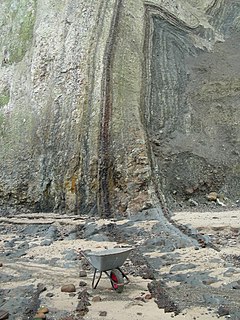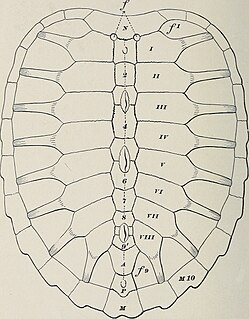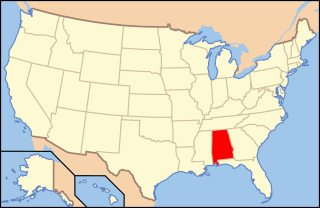
Turtles are reptiles of the order Chelonia or Testudines. They are characterized by a special bony or cartilaginous shell developed from their ribs that acts as a shield. Colloquially, the word "turtle" is generally restricted to fresh-water and sea-dwelling Testudines. Testudines includes both extant (living) and extinct species. Its earliest known members date from the Middle Jurassic. Turtles are one of the oldest reptile groups, more ancient than snakes or crocodilians. Of the 360 known extant species, some are highly endangered.

Padre Island National Seashore (PINS) is a national seashore located on Padre Island off the coast of South Texas. In contrast to South Padre Island, known for its beaches and vacationing college students, PINS is located on North Padre Island and consists of a long beach where nature is preserved.

Archelon is an extinct marine turtle from the Late Cretaceous, and is the largest turtle ever to have been documented, with the biggest specimen measuring 460 cm (15 ft) from head to tail, 400 cm (13 ft) from flipper to flipper, and 2,200 kg (4,900 lb) in weight. It is known only from the Dakota Pierre Shale and has one species, A. ischyros. In the past, the genus also contained A. marshii and A. copei, though these have been reassigned to Protostega and Microstega, respectively. The genus was named in 1895 by American paleontologist George Reber Wieland based on a skeleton from South Dakota, who placed it into the extinct family Protostegidae. The leatherback sea turtle was once thought to be its closest living relative, but now, Protostegidae is thought to be a completely separate lineage from any living sea turtle.

The green sea turtle, also known as the green turtle, black (sea) turtle or Pacific green turtle, is a species of large sea turtle of the family Cheloniidae. It is the only species in the genus Chelonia. Its range extends throughout tropical and subtropical seas around the world, with two distinct populations in the Atlantic and Pacific Oceans, but it is also found in the Indian Ocean. The common name refers to the usually green fat found beneath its carapace, not to the color of its carapace, which is olive to black.

The Alabama red-bellied cooter or Alabama red-bellied turtle, is native to Alabama. It belongs to the turtle family Emydidae, the pond turtles. It is the official reptile of the state of Alabama.

Protostega is an extinct genus of sea turtle containing a single species, Protostega gigas. Its fossil remains have been found in the Smoky Hill Chalk formation of western Kansas and time-equivalent beds of the Mooreville Chalk Formation of Alabama. Fossil specimens of this species were first collected in 1871, and named by Edward Drinker Cope in 1872. With a length of 3 metres (9.8 ft), it is the second-largest sea turtle that ever lived, second only to the giant Archelon, and the third-largest turtle of all time behind Archelon and Stupendemys.

Protostegidae is a family of extinct marine turtles that lived during the Cretaceous period. The family includes some of the largest sea turtles that ever existed. The largest, Archelon, had a head one metre (39 in) long. Like most sea turtles, they had flattened bodies and flippers for front appendages; protostegids had minimal shells like leatherback turtles of modern times.

The Fur Formation is a marine geological formation of Ypresian age which crops out in the Limfjord region of Denmark from Silstrup via Mors and Fur to Ertebølle, and can be seen in many cliffs and quarries in the area. The Diatomite Cliffs is on the Danish list of tentative candidates for World Heritage and may become a world Heritage site.
Corsochelys is an extinct genus of sea turtle that lived in the Late Cretaceous (Campanian). Zangerl (1960) named the type species, based upon remains found in Alabama within the Mooreville Chalk Formation.

Ctenochelys is an extinct genus of marine turtle, which existed during the Cretaceous period, and lived in the shallow waters of the Western Interior Seaway. Its fossils have been found in the Ripley Formation and Mooreville Chalk of central Alabama, United States. It was first named by C.H. Sternberg in 1904, and contains two species, C. stenoporus and C. acris.

Toxochelys is an extinct genus of marine turtle from the Late Cretaceous period. It is the most commonly found fossilized turtle species in the Smoky Hill Chalk, in western Kansas.
Bouliachelys is an extinct genus of sea turtle from Cretaceous Australia. Its parent taxon is the clade Dermochelyoidae.
Carolinochelys is an extinct genus of sea turtle from Oligocene of United States. It contains one species: C. wilsoni, and was first named by O.P. Hay in 1923.

Peritresius is an extinct genus of sea turtle from the Late Cretaceous deposits in the US Eastern Seaboard.

The hawksbill sea turtle is a critically endangered sea turtle belonging to the family Cheloniidae. It is the only extant species in the genus Eretmochelys. The species has a worldwide distribution, with Atlantic and Indo-Pacific subspecies—E. i. imbricata and E. i. bissa, respectively.

Pleurosternon is an extinct genus of cryptodire turtle from the late Jurassic period to the early Cretaceous period. Its type species, P. bullocki was described by the paleontologist Richard Owen in 1853. Since then, and throughout the late 19th century, many fossil turtles were incorrectly assigned to this genus.

Paleontology in Alabama refers to paleontological research occurring within or conducted by people from the U.S. state of Alabama. Pennsylvanian plant fossils are common, especially around coal mines. During the early Paleozoic, Alabama was at least partially covered by a sea that would end up being home to creatures including brachiopods, bryozoans, corals, and graptolites. During the Devonian the local seas deepened and local wildlife became scarce due to their decreasing oxygen levels.

The prehistory of the United States comprises the occurrences within regions now part of the United States of America during the interval of time spanning from the formation of the Earth to the documentation of local history in written form. At the start of the Paleozoic era, what is now "North" America was actually in the southern hemisphere. Marine life flourished in the country's many seas, although terrestrial life had not yet evolved. During the latter part of the Paleozoic, seas were largely replaced by swamps home to amphibians and early reptiles. When the continents had assembled into Pangaea drier conditions prevailed. The evolutionary precursors to mammals dominated the country until a mass extinction event ended their reign.

Desmatochelys padillai is an extinct species of sea turtle described in 2015 and belongs to the family Protostegidae. Estimated to be more than 120 millions years old, it became the oldest known sea turtle, superseding a record earlier held by Santanachelys gaffneyi, which was described in 1998. The fossil, including bones and shells, was discovered from Villa de Leyva in Colombia in 2007. The specimen is larger than an average-sized human, measuring 2 m in length, and exhibits the key features of modern sea turtles. The specific name is given in honour of Carlos Bernardo Padilla, a renowned supporter of the palaeontology of the region.

The Mississippi–Alabama barrier islands are a chain of barrier islands in the Gulf of Mexico along the coasts of Mississippi and Alabama enclosing the Mississippi Sound. The major islands are Cat Island, Ship Island, Horn Island, Petit Bois Island, and Dauphin Island. The islands are separated by wide inlets, several of which have been channelized to form the shipping channels for Gulf coast ports. The shapes and sizes of the islands have changed significantly since the 1800s, with the islands generally shrinking and shifting westward, especially after major tropical cyclones. Most of the islands are uninhabited. Much of the Mississippi portion of the chain is included in the Gulf Islands National Seashore.

















